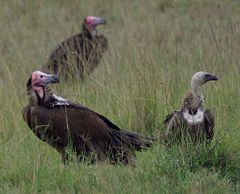Old World vulture
| Old World vultures | ||||||||||||
|---|---|---|---|---|---|---|---|---|---|---|---|---|
 Lappet-faced Vultures (left) and a White-backed Vulture
| ||||||||||||
| Scientific classification | ||||||||||||
| ||||||||||||
|
See text. |
Old World vultures belong to the family Accipitridae, which also includes eagles, buzzards, kites, and hawks.
Old World vultures are not closely related to the superficially similar New World vultures and condors, and do not share that group's good sense of smell. The similarities between the two groups of vultures are due to convergent evolution rather than a close relationship. They were widespread in both the Old World and North America, during the Neogene. Old World vultures are probably a polyphyletic group within Accipitridae, with Palm-nut Vulture, Egyptian Vulture and Lammergeier separate from the others.[1]
Both Old World and New World vultures are scavenging birds, feeding mostly from carcasses of dead animals. Old World vultures find carcasses exclusively by sight. A particular characteristic of many vultures is a bald head, devoid of feathers. If vultures had head feathers, they would become spattered with blood and other fluids when the vultures ate flesh from carcasses, and thus would be difficult to keep clean.
Some species of vulture are very susceptible to diclofenac poisoning, which causes the birds to suffer from renal failure and death, and this had caused a very marked decrease in wild vulture populations in the Asian subcontinent, where diclofenac used for farm animals has directly led to poisoning of vultures. Often farm animal carcases containing diclofenac in their flesh are left out in to open for vultures to eat and tidy up. Meloxicam has been found to be harmless to vultures and should prove an acceptable alternative to diclofenac.
Species
Genus Aegypius
- Eurasian Black Vulture or Monk Vulture, Aegypius monachus
Genus Gypaetus
- Lammergeier or Bearded Vulture, Gypaetus barbatus
Genus Gypohierax
- Palm-nut Vulture, Gypohierax angolensis
Genus Gyps
- Griffon Vulture Gyps fulvus
- Indian White-rumped Vulture, Gyps bengalensis
- Rüppell's Vulture, Gyps rueppelli
- Long-billed Vulture Gyps indicus
- Slender-billed Vulture Gyps tenuirostris
- Himalayan Griffon Vulture Gyps himalayensis
- White-backed Vulture, Gyps africanus
- Cape Griffon, Gyps coprotheres
Genus Necrosyrtes
- Hooded Vulture, Necrosyrtes monachus
Genus Neophron
- Egyptian Vulture, Neophron percnopterus
Genus Sarcogyps
- Red-headed Vulture, Sarcogyps calvus
Genus Torgos
- Lappet-faced Vulture, Torgos tracheliotus
Genus Trigonoceps
- White-headed Vulture, Trigonoceps occipitalis
ReferencesISBN links support NWE through referral fees
- ↑ Lerner HR, Mindell DP (2005). Phylogeny of eagles, Old World vultures, and other Accipitridae based on nuclear and mitochondrial DNA. Mol. Phylogenet. Evol. 37 (2): 327–46.
Credits
New World Encyclopedia writers and editors rewrote and completed the Wikipedia article in accordance with New World Encyclopedia standards. This article abides by terms of the Creative Commons CC-by-sa 3.0 License (CC-by-sa), which may be used and disseminated with proper attribution. Credit is due under the terms of this license that can reference both the New World Encyclopedia contributors and the selfless volunteer contributors of the Wikimedia Foundation. To cite this article click here for a list of acceptable citing formats.The history of earlier contributions by wikipedians is accessible to researchers here:
The history of this article since it was imported to New World Encyclopedia:
Note: Some restrictions may apply to use of individual images which are separately licensed.